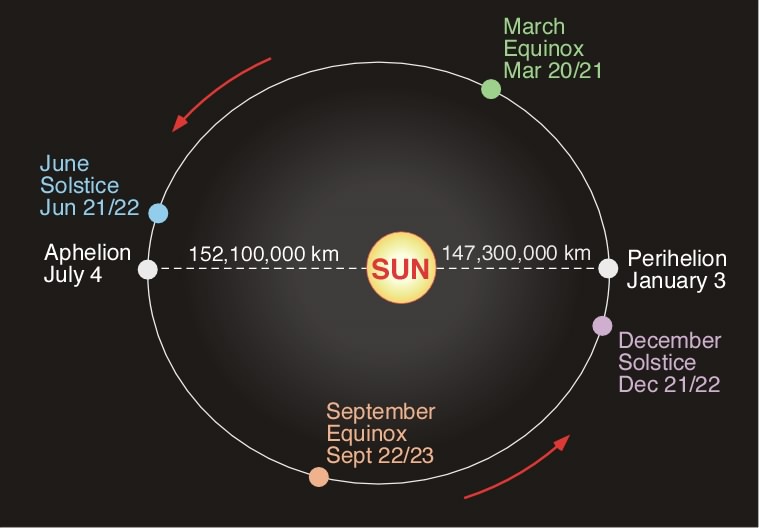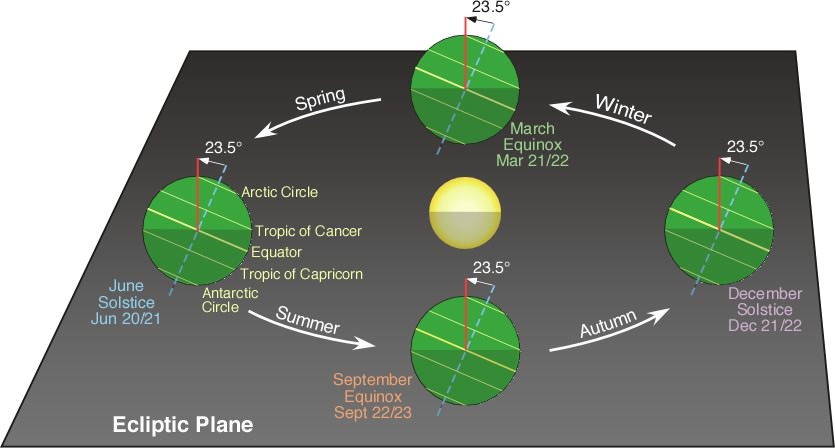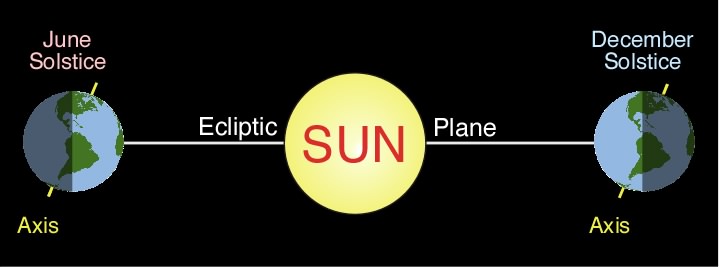The orbit of the Earth around the Sun is called an Earth revolution. This celestial motion takes 365.26 days to complete one cycle. Further, the Earth's orbit around the Sun is not circular, but oval or elliptical (see Figure 6h-2). An elliptical orbit causes the Earth's distance from the Sun to vary over a year. Yet, this phenomenon is not responsible for the Earth’s seasons! This variation in the distance from the Sun causes the amount of solar radiation received by the Earth to annually vary by about 6%. Figure 6h-2 illustrates the positions in the Earth’s revolution where it is closest and farthest from the Sun. On January 3, perihelion, the Earth is closest to the Sun (147.3 million km). The Earth is farthest from the Sun on July 4, or aphelion (152.1 million km). The average distance of the Earth from the Sun over a one-year period is about 149.6 million km.

Tilt of the Earth's Axis
The ecliptic plane can be defined as a two-dimensional flat surface that geometrically intersects the Earth's orbital path around the Sun. On this plane, the Earth's axis is not at right angles to this surface, but inclined at an angle of about 23.5° from the perpendicular. Figure 6h-3 shows a side view of the Earth in its orbit about the Sun on four important dates: June solstice, September equinox, December solstice, and March equinox. Note that the angle of the Earth's axis in relation to the ecliptic plane and the North Star on these four dates remains unchanged. Yet, the relative position of the Earth's axis to the Sun does change during this cycle. This circumstance is responsible for the annual changes in the height of the Sun above the horizon. It also causes the seasons, by controlling the intensity and duration of sunlight received by locations on the Earth. Figure 6h-4 shows an overhead view of this same phenomenon. In this view, we can see how the circle of illumination changes its position on the Earth’s surface. During the two equinoxes, the circle of illumination cuts through the North Pole and the South Pole. On the June solstice, the circle of illumination is tangent to the Arctic Circle (66.5° N) and the region above this latitude receives 24 hours of daylight. The Arctic Circle is in 24 hours of darkness during the December solstice.


On June 21 or 22 the Earth is positioned in its orbit so that the North Pole is leaning 23.5° toward the Sun (Figures 6h-3, 6h-4, 6h-5 and see animation - Figure 6h-7). During the June solstice (also called the summer solstice in the Northern Hemisphere), all locations north of the equator have day lengths greater than twelve hours, while all locations south of the equator have day lengths less than twelve hours (see Table 6h-2). On December 21 or 22 the Earth is positioned so that the South Pole is leaning 23.5 degrees toward the Sun (Figures 6h-3, 6h-4, 6h-5 and see animation - Figure 6h-8). During the December solstice (also called the winter solstice in the Northern Hemisphere), all locations north of the equator have day lengths less than twelve hours, while all locations south of the equator have day lengths exceeding twelve hours (see Table 6h-2).


No comments:
Post a Comment